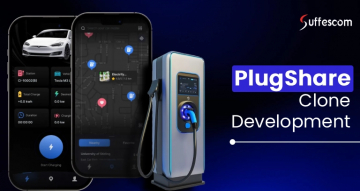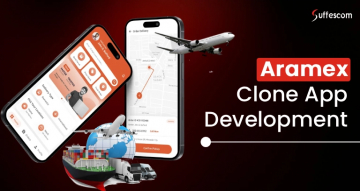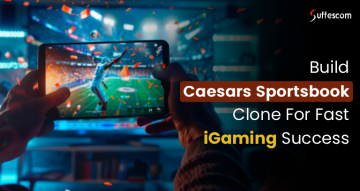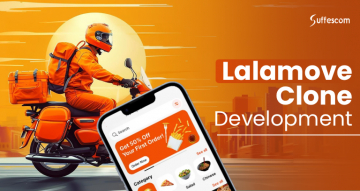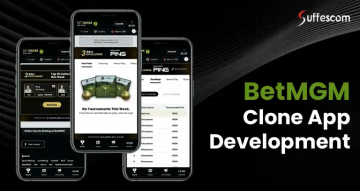Develop a Fitness App Like Freeletics: Transform Health & Fitness Experiences
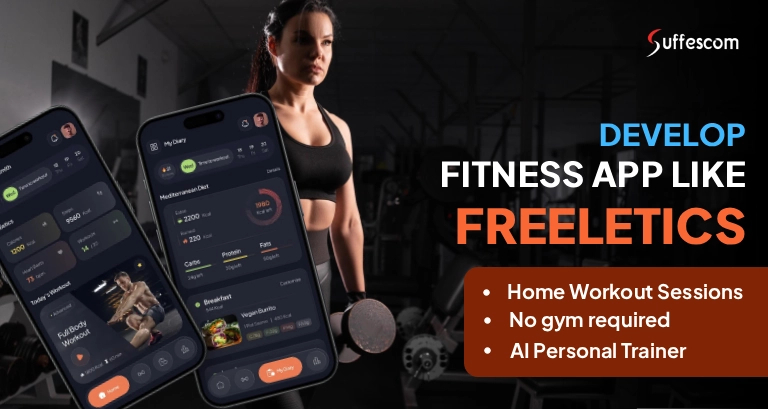
Fitness trends are changing very quickly, and among them, the AI-based fitness apps like Freeletics are leading the way. Gym trainers and nutritionists build apps like Freeletics that offer personalized, AI-powered fitness routines that adapt to each user’s goals, fitness level, and progress. Unlike fixed gym workouts, users enjoy the flexibility to train anywhere, anytime, with guidance and real-time feedback. This customized, data-driven approach makes fitness more convenient, engaging, and sustainable for long-term results.
Freeletics is one of the leading examples of a fitness app, powered by AI. It has over 59 million users worldwide, and close to $900,000 is its monthly revenue. So, if you are thinking of creating fitness apps, then developing a Freeletics clone could be your best bet.
You know that the global fitness app market was worth around $10 billion in 2024. Now, it is expected to be worth $33 billion in 2033. That is a huge leap! And this showcases that it has a great future scope.
Explore important points about Freeletics clone development:-
What makes it successful?
How to build it?
How much to invest and ways to make a profit?
Why Freeletics is the King of the Fitness Apps and Why It is the Perfect Model for Cloning
Freeletics did not only gain popularity but also changed the way people view fitness. The app applies AI in creating personalized training routines for every user based on their physical condition, objectives, and progress. The app adapts to users' routines as they get better over time, making the entire process both challenging and rewarding. No gym facilities required, thus, Freeletics is the most flexible option, whether you are at home, in a park, or on a business trip.
However, the true magic occurs within the community. Freeletics encourages its users to share their achievements, show each other their fitness levels, and give each other support. This social interaction is the biggest factor of accountability and thus the retention of users for the longest period of time, among the bigger reasons for its phenomenal success.
Similar to this, there will be a unique feature in the quickly growing market for AI fitness apps. While AI fitness applications are predicted to expand at an impressive rate of approx.13% annually, the entire fitness industry is predicted to grow from $98 billion in 2023 to over $172 billion by 2028. More people are coming up with money for technologically assisted and customized wellness solutions. The millennials and Gen Z, over 70% of the total userbase, are at the forefront of the demand for data-backed and smart coaching experiences.
It is obvious that fitness will be digital, smart, and ultra-personalized in the future with the rise of wearables and home exercise. So, to develop an app like Freeletics today, thus, could put you at the forefront tomorrow.
Avail The Next Level Fitness Revolution With AI
Develop an intelligent, AI-based fitness app like Freeletics that actually delivers results and also drives massive engagement.
Freeletics Successful Business Model: Multiple Streams of Revenue
Freeletics Clone app earns money with intelligent methods that do not bother users. Here's how:
Freemium Model: The Portal to Premium
The application is available free of charge, and you receive some fundamental features without spending a penny. This brings plenty of individuals to test it. Once individuals experience how great it is, they crave more. That is when they pay for the upgraded version. It is a seamless method of turning free users into paying subscribers.
Subscription Plans: Recurring Revenue Powerhouse
The paid version gives access to AI coaching, pro features, and improved workout plans. They can opt for a monthly, quarterly, or yearly subscription. This generates consistent, predictable revenue. The longer subscribers stay, the more revenue the app generates. It's much superior to one-time purchases.
In-App Purchases: Personalization for Additional Revenue
Apart from subscriptions, people can purchase additional things such as customized diet plans or special training regimens. This provides people with additional options and generates additional revenue.
Corporate Partnerships: Accessing B2B Markets
Businesses need healthy workers, so Freeletics collaborates with them to offer their employee fitness programs. This generates large deals with bulk rates.
Strategic Brand Partnerships and Affiliate Marketing
The app suggests relevant fitness tools, supplements, and training accessories. When users purchase from these suggestions, Freeletics earns a commission. Win-win for both parties.
Such a multi-layer strategy implies that money is derived from various sources, and the business is more stable and profitable.
Mandatory Features That Make Freeletics Clone Stand Out
If you are planning to build an app like Freeletics, you will need to focus on intelligent, user-friendly features that make the users’ experience personalized and engaging. Listing some of the must-have features:
AI-Powered Personalized Workouts
This is the basic feature of the Freeletics Clone app. The AI should look at each user's fitness level, goals, and progress to create custom workout plans. As people get stronger, the workouts automatically adjust. It should not just ask basic questions. Your AI should consider things like how tired someone is, how they performed last time, and even their stress levels to create truly personal plans.
Comprehensive Exercise Library
You require plenty of exercises with good video demonstrations. It showcases the correct way for individuals to perform every movement to avoid injury. It provides simple, medium, and challenging versions of every exercise to allow beginners and professionals to utilize your application equally.
Digital AI Coach
It is like having an actual personal trainer with you always. It provides feedback on workouts, adjusts the difficulty according to your performance, and gives motivational messages. Make your AI trainer personality friendly, demanding, or encouraging, depending on your audience. This makes users feel engaged with the app.
Progress Tracking and Analytics
Users also have to see their progress in order to stay motivated. Keep a record of workouts completed, calories burned, personal records, and body measurements. Display this information using easily readable charts. The more information users receive, the more your app will be used.
Flexible Training Plans
Various individuals have various objectives. Some desire to lose weight, while others desire enhanced muscles. Your app needs to deal with all of this. Users should also be able to modify their schedule. Life is hectic, so they require convenience with exercise days and times.
Offline Mode Feature
Users should be able to download exercises and should access exercises offline. This is absolutely vital for individuals who travel or exercise where wifi is poor.
Social and Community Features
Enable users to create profiles, post progress, challenge friends, and enjoy wins collectively. Include a community feed where individuals can share updates and pictures. It also contains group challenges and leaderboards to make it friendly and competitive.
Personalized Nutrition Guidance
Exercise is actually half the battle, food also matters. Provide meal plans for each user based on their goals and dietary preferences. Also offers recipes, calorie counting, and meal suggestions. It ensures that the nutrition guidance complements the workout routines for improved results.
User-Friendly Profile Management
Keep it easy to manage the user's account, update goals, monitor progress, and process payments. A simple, clean interface does everything better.
Strong Admin Panel
You'll require a solid dashboard to stay on top of all that. This should enable you to administer users, create new workouts, observe the number of users going through the app, deal with subscriptions, and assist clients with issues.
Add Advanced Features to Future-Proof Your AI Freeletics Fitness Clone App
If you are ready to truly stand out in Freeletics clone development, introduce these cutting-edge features:
Real-Time Form Correction Using AI
Take advantage of the camera on the phone to observe how users move through exercises. The AI can identify errors and provide immediate feedback to avoid injuries.
Wearable Device Integration
Integrate the clone app with Apple Watch, Fitbit, and other fitness trackers. Employ heart rate, steps, and sleep in making workouts even more tailored.
Augmented Reality (AR) and Virtual Reality (VR) Workouts
AR can place a virtual trainer in your living room. VR can carry you to a virtual gym or an outdoor setting. These simulated technologies make exercising so much more interesting and enjoyable.
Voice-Controlled Interface
Develop an App Like Freeletics with a voice-controllable feature. This is amazingly convenient if your hands are occupied while exercising.
Gamification Elements
Add achievement badges, levels, leaderboards, and rewards. Individuals enjoy games, and making fitness a game brings them back.
Mental Wellness Integration
Add guided meditation, breathing exercises, and stress relief strategies because fitness is not only physical, mental health is important as well.
Advanced Biometric Analysis and Injury Prevention
Utilize health information to detect when a person may get hurt. If the AI detects warning signs, it can offer simpler workouts or rest days.
Multilingual Support
Make your app available in various languages in order to access individuals globally. This provides enormous new markets.
Technology Stack for Building Freeletics Clone
Selecting the right technology is a significant factor in the Freeletics clone development process. Here is what you need:
Frontend Development Technologies
The use of Swift for the iPhone and Kotlin for Android is recommended since these are the modern standards.
Do you want to reduce the budget? React Native or Flutter can be used. These two technologies allow building for both iPhone and Android at once using one codebase. This can lead to a reduction of 30-40% in the cost of Freeletics clone app development.
Backend Development Framework
Node.js is an excellent choice for apps that experience heavy user load. Python with Django or Flask is a great pick for the AI features. Ruby on Rails is a fast development framework with clear, readable code. The one that your team is the most skilled in is the way to go.
AI and Machine Learning Technologies
TensorFlow and PyTorch are the top ones when it comes to building intelligent AI features in the industry. They not only make your workout recommendations smart but also keep them personalized and adaptive. Scikit-learn can analyze user data to such an extent that it can predict users' future needs.
Database Management Systems
MongoDB is the one that handles unstructured and flexible data best, and it is also perfect for workout logs and user progress. As for PostgreSQL and MySQL, they are suitable for structured data like user accounts and payments. The use of both types of databases together is a common practice in many successful applications.
Cloud Services Infrastructure
You have the option of AWS, Google Cloud, or Microsoft Azure. All of them offer very powerful servers that you do not have to buy or maintain. Long-term cloud services are a more cost-effective solution and can handle larger numbers of users without compromising on speed.
Essential Third-Party Integrations
In the case of payments, go with Stripe, PayPal, or Braintree. These options process credit card transactions safely. For sending workout reminders, the use of Firebase Cloud Messaging (for Android) and Apple Push Notification Service (for iPhone) is recommended for push notifications. Google Analytics or Mixpanel can help you understand the users' behavior in your app better.
Does Your Fitness Business Deserve The Best Development Team?
From design to deployment, Suffescom Solutions ensures your app stands out in the global fitness market.
Followed Comprehensive Procedure for Building Freeletics Clone
Below is the detailed process for Freeletics Clone development, starting from scratch:
Market Research & Strategic Planning
The very first thing is to analyze the market with respect to other fitness apps. What are their strong points? What do the users criticize? Discover the opportunities that you will be able to fulfill.
Find out exactly for whom you will be designing. What are their actual fitness goals? Are the users going to be tech-savvy? What would be the approximate range of their spending budget?
Thus, a plan with a specific target, a timeline, and a budget should be made. It generally takes 2-3 weeks, but it brings you victory.
UI and UX designing along with prototyping
Imagine and sketch the UI and UX for your app. Create visuals that will represent the layout of every single screen so that users can understand and use them efficiently.
Make it so easy and engaging that users should be able to do everything within just a few taps. Take your design to actual users for usability testing, and only then code it.
Aesthetics are costly, but it is the most rewarding. This phase lasts 2-3 weeks.
MVP Building
It is not necessary to do the whole thing at once. At first, develop only the Minimum Viable Product (MVP) which will come with essential features only: user accounts, very basic AI workouts, limited exercise library, simple progress tracking, and short profiles.
Make sure there are no bugs in the given features. A basic app that is running fine is preferable to a complicated app that is malfunctioning. This phase requires 8-12 weeks.
AI Algorithm Development and Incorporation
This is the turning point; your app turns smart. Now, it’s time to train AI to suggest personalized recommendations based on the user's data.
AI will gradually become more intelligent as the number of users increases. This phase lasts 4-6 weeks and simultaneously takes place with MVP development.
Advanced Feature Enhancement
By the time and after the MVP is live and customers are interacting with it, the remaining functions that were based on users' wants can be added later. Incorporate social network tying, diet plans, integration with wearable devices, and gamification.
Prioritize what users want most first. This takes 4-6 weeks.
Testing and Quality Assurance
Test it thoroughly. Make sure all features work, the app is intuitive, fast, and secure.
Let actual people test it in the middle of an actual workout. And accordingly resolve all bugs beforehand. This takes 3-4 weeks.
App Store Deployment and Launch
Make app store listings excellent with good descriptions and visually appealing screenshots. Submit them to the Apple App Store and Google Play Store.
Arrange a grand launch with social media posts, press releases, and special promotions. Because we know first impressions count!
The whole process takes 3-6 months from start to launch, and it all depends on the complexity of your app.
Freeletics Clone App Development Cost: Complete Breakdown
Now let's talk about money. How much does it cost to develop an App Like Freeletics? We’ll see how different levels of development affect the price. Here's what it costs:
- Basic Freeletics Clone Development: $5,000 - $10,000
This type of app version contains core features such as user accounts, default workouts, basic AI suggestions, tracking of progress, and minimal design.
It is suitable for proving your concept.
- Mid-Level App with Advanced Features: $10,000 - $15,000
This entails personalized AI coaching, social aspects, wearable integration, nutrition support, offline capability, improved design, and a full admin panel.
This level provides you with a market-ready product that can acquire and retain users.
- High-End AI Fitness App: $15,000 - $25,000
The premium version includes everything above, plus real-time form correction, AR/VR workouts, advanced health tracking, voice control, gamification, mental wellness features, and multiple languages.
This creates a truly unique app that stands out.
Key Factors That Influence The Cost
The cost of developing an AI-based fitness app like Freeletics is determined by a number of factors, some of which are the following:
- Platform Choice: The cost of Android and iPhone apps being developed separately is higher than that of cross-platform tools like React Native. Cross-platform can factor a cost reduction of 30-40%.
- Design Complexity: Unique designs & custom animations are costly, but they are the reason your app will not be the same as others in the market.
- AI Sophistication: The cost of AI varies depending on the type of AI that is developed. Simple AIs cost less than sophisticated ones that adapt in real-time. More advanced AI means better personalization.
- Location of Development Team: Developer costs vary by location. For instance, hiring Asian AI engineers is less expensive than hiring American or European ones.
- Third-Party Services: Remember to account for ongoing costs like analytics software, cloud hosting, and payment processing.
- Continuous Upkeep and Updates: Be prepared to invest 15–25% of your annual capital to bug repairs, upgrades, server fees, and new feature additions after the app launches.
Reduce The Cost of Freeletics Clone Development
You may cut costs without sacrificing the standard of your application by following these points:
- One can start with an MVP version and roll out other features in phases.
- Use cross-platform development instead of native.
- Hire talented teams from low-cost locations.
- Go for reliable and proven technologies.
- Instead of making everything custom, introduce features gradually to share the costs.
Overcoming Challenges in AI Fitness App Development
It is not easy to develop an AI-based fitness app like Freeletics. The following are the challenges that occur in Freeletics Clone development, along with ways to solve them:
Complex AI Integration
Challenge: The AI fitness app development is a long and complex process that requires inputs and efforts from experts
Solution: Partner with AI experts or use famous libraries like TensorFlow. Start with basic AI and keep increasing its capabilities. For better AI integration, use data from your first users to train the AI.
Data Security and Privacy
Challenge: Medical fitness apps take care of very delicate health information. In the event of a security breach, trust may be irreparably damaged and legal action may result.
Solution: Create robust encryption, employ safe authentication procedures, and abide by privacy laws like the GDPR. Execute security audits often. In your agreement with users, make clear what you do with the data.
High Development Costs
Challenge: The Freeletics Clone app development cost is very high for building a complete-featured AI fitness app.
Solution: Before spending money on all the features, create an MVP to show that your concept works. Give top priority to the needs of your customers. Develop in stages to distribute costs.
User Engagement and Retention
Challenge: Many people install several fitness apps, but after a short time, they do not use them anymore.
Solution: Incorporate gamification with rewards and achievements. Develop community features for accountability. Send intelligent push notifications, none too many, just a few. Continue to add new workouts and challenges. Improve the sections of your app where people fall off.
Market Competition
Challenge: The market for fitness apps is filled with established players.
Solution: Identify your niche. Focus on one form of fitness, age group, or area. Do one thing extremely well rather than forming a mediocre brand.
Technical Performance Issues
Challenge: Fitness apps must process video, real-time data, and sophisticated calculations without stalling.
Solution: Code efficiently from the beginning. Employ content delivery networks to load video quickly. Test across various phones and internet speeds.
Regulatory Compliance
Challenge: Providing fitness and health recommendations has legal obligations.
Solution: Consult lawyers familiar with health tech. Include medical advice disclaimers. Keep up to date with regulations in various countries.
Marketing Your Freeletics Clone: From Launch to Growth
Developing a fantastic app is merely half the battle. You must also get users for its success.
Pre-Launch Marketing Strategy
Begin marketing when your app is not yet complete. Build a website that gathers email addresses. Post development news on social media to generate buzz. Recruit beta testers who will be your initial fans. Collaborate with fitness bloggers so that they will review your app when it is released.
App Store Optimization (ASO)
This is app store search engine optimization. Conduct keyword research such as "AI fitness app,"
"workout planner," and "bodyweight training." Craft a fantastic app description with these keywords. Design eye-catching screens. Build a demo video—videos greatly boost downloads. Encourage satisfied users to leave positive reviews. Reviews are crucial for rankings.
Launch Campaign Tactics
Plan a mass launch. Distribute press releases. Provide promotions on launch day or free trials. Provide users with rewards for inviting friends through a referral program. Use social media with interesting content such as makeover tales and exercise tips. Facebook and Instagram pay-per-click ads can get a lot of downloads. Use them.
Techniques for Growth and Retention
After launch, focus on keeping existing users rather than just gaining new ones. Create informative content, including blog posts and videos, that includes success stories and workout advice.
- Collaborate with allied firms, such as healthy eating services or exercise equipment companies.
- Get users to report progress and mention your app.
- Highlight the top user stories in your marketing.
- Continuously monitor what marketing is most effective and do more of it.
Future Proofing of Fitness App: Trends and Scalability
We have seen with the numbers that the trend of AI fitness apps is not going to fade soon. Consider the future in AI for creating enduring success:
Emerging Trends to Watch
The AI in nutrition is becoming smarter. Soon, apps may scan food images to monitor calories automatically. Mental health functions will take center stage. Metaverse fitness experiences and NFT rewards could open up new possibilities. Improved wearables will allow even more tailored workouts.
Accelerate Your Fitness Business
As soon as your business achieves the desired results, it can expand into new markets. It can launch new fitness categories, such as yoga and sports training, collaborate with corporate wellness programs through business associations, and facilitate the development of white label products for resale.
Establishing an Ecosystem of Sustainable Fitness
Think beyond an app. You may include online coaching, an equipment shop, gym partnerships, and educational content. The top AI Fitness App Like Freeletics has become an end-to-end wellness platform that meets users’ everyday needs for fitness.
Conclusion: Your Roadmap to Fitness App Success
The chance to build an app like Freeletics comes at a time when the market for $12 billion fitness apps is at its most demanding. It is time to act, as consumers are looking for more advanced, AI-powered, and personalized fitness experiences.
The path to success is to determine what makes Freeletics exceptional and add your own dash of creativity, not by replication. Use a combination of a comprehensive study, an elementary MVP, and excellent AI personalization. The app should be user friendly, scalable, and community centric. There must be a balance between real user value and monetization.
Yes, it is an investment, but so are the returns. And don't forget, launching is only step one. Just keep on refining, adding features, hearing from your users, and growing with trends. That's how successful apps come to be.
The fitness revolution has already arrived. With the correct team and solid vision in place, like Suffescom Solutions, your Freeletics clone can be the next success story, motivating millions of people around the globe.
Build Your Freeletics Clone With Suffescom Solutions
Ready to materialize your fitness app idea? Suffescom Solutions is a leading AI development company in creating high-end, scalable, and feature-packed Freeletics clone apps that fit your brand and target audience. Our expert developers integrate AI, machine learning, and trendy UI/UX to design fitness solutions that distinguish themselves from the rest.
Whatever your requirement - a custom app or a white-label Freeletics clone - we provide end-to-end development from strategy to post-launch support. Team up with Suffescom today and make your vision a successful AI fitness platform that people adore.
Build Your Own AI Fitness Empire Today
Launch an AI-based fitness app like Freeletics and do innovation with Suffescom’s expert development team.
Frequently Asked Questions
What does it cost for Freeletics clone app development?
A Freeletics clone app usually costs $10,000 for developing a basic version. And for a feature-rich app with advanced AI and AR/VR, it will cost around $30,000. At Suffescom, we are known for providing genuine pricing and excellent results together. Our end cost is also based on whether you develop for iPhone and Android separately or combined, how intelligent you want your AI to be, how stylish your design should be, and where your development team is located.
Does it take long to create an AI fitness app like Freeletics?
Mostly, it takes around 3 to 6 months from conceptualization to getting the app out in the market. The period for research is 1 to 2 weeks, for design 2 to 3 weeks, the first working version 6 to 8 weeks, AI functionalities 2 to 4 weeks, additional functionalities 3 to 4 weeks, and testing 2 to 3 weeks. Also, you can start the launch with the most basic functionality, then add more according to the customer feedback.
What are the bare minimums needed in a Freeletics clone?
You will need AI-powered personalized workouts, a huge library of exercises with videos, and an AI coach to give feedback. Additionally, you will have to incorporate progress visualization, workout programs for different goals, offline functionality allowing users to exercise without internet access, social media integration for user interaction. It should also provide nutrition assistance including meal planning, straightforward profile management, and a control dashboard for the app.
In a competitive market, how can I differentiate my Freeletics clone?
Stand out from the competition by using features such as wearable integrations, mental wellness materials, gamified challenges, or real-time AI form correction. The use of community-oriented and tailored features significantly boosts retention and interaction.
Which company should I choose for Freeletics clone development?
Suffescom Solutions has a proven record in AI fitness app development, combining AI, ML, and UX excellence. We offer full-cycle development from MVP to launch and maintenance. Our experts also make sure that your Freeletics clone app is expandable, secure, and ready for the market.
Do I need to have different apps for iOS and Android?
Not necessarily. Though individual iPhone and Android apps are ideal, cross-platform solutions like React Native or Flutter allow you to develop both from a single code, reducing your Freeletics clone development expense by 30-40%. For your initial version and tight budgets, cross-platform is the wiser choice. You can always develop individual apps afterwards when you have more users and resources.
